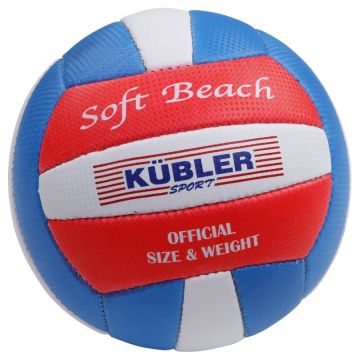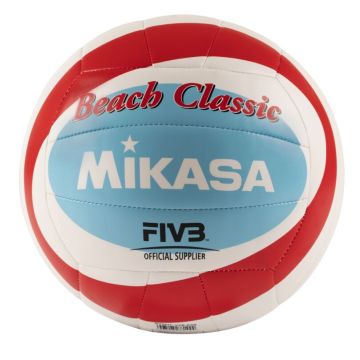
Beach Volleyball Balls
Fast rallies in the sand with beach volleyball balls
What differences are there between beach volleyball balls and an indoor volleyball balls?
With a circumference of 66 - 68 cm, a beach volleyball ball is slightly larger than a regular indoor volleyball ball. Because beach volleyball balls are used outdoors, it has to be resistant to sand and (salt) water. An abrasion-resistant and water-repellent surface and specially processed seams make the beach volleyball ball robust, non-slip and reasonably weatherproof. The seams also ensure that the volleyball can be braked by the air much more easily and therefore flies slower, the soft surface means that less rapid shots can be made. Compared to indoor volleyball, beach volleyball is also softer and has a noticeably lower internal pressure with 171 mbar to a maximum of 221 mbar. The size, the lower air pressure and the surface are deliberately chosen so that the game is slower. Since beach volleyball is played on an almost the same size of field as in the hall, but only for two in the team and also in the challenging sand, the teams have more time for defence and longer rallies can occur.
What characterises a good and high-quality beach volleyball ball?
A good beach volleyball ball is characterized by optimally processed seams and high-quality material. These enable good ball control and precise play. The following also applies: the fewer individual panels the surface consists of, the better the beach volleyball ball can absorb the energy of the impact. The inside of the bladder should also be stable.
How do I treat my beach volleyball ball?
A beach volleyball ball needs a little more care than an indoor volleyball. For a longer longevity of the ball, every volleyball player should remove their sand from the sand after playing with a soft, damp cloth. In the case of heavier dirt, mild dish washing liquid or leather cleaner will help, after which the beach volleyball ball should be rinsed with clear cold water and dried. If you are not going to play for a longer period of time, deflate the ball and keep the ball in a dry, cool, sun-protected place.
Buying the right beach volleyball ball
Regardless of whether you and your teams want to buy a high-quality beach volleyball ball for tournaments or a beach volleyball ball for a leisure match on the beach, you will find the right beach volleyball ball in our range. For admission as a game ball or competition ball at tournaments and in league operations, the beach volleyball balls must be certified with DVV Beach 1 (league operations above the national associations) or DVV Beach 2 (lower league operations) and the FIVB certification mark. For the school there is the DVV Beach certification mark. With the Mikasa Beach Champ VLS300 you will find the official volleyball for the Olympic Games, the FIVB World Tour and many other tournaments and national associations. The Beach Champ is characterized by a low rebound effect, an increased contact time, an optimal shape and excellent water resistance. The Mikasa Soft Sand Volleyball has a particularly soft surface and has been awarded the DVV test mark. It is therefore perfect for use in school, on the beach and in leisure time. With the DVV1 certification mark, the Molten Beach Volleyball V5B5000 is a ball that is also suitable for higher league operations.











